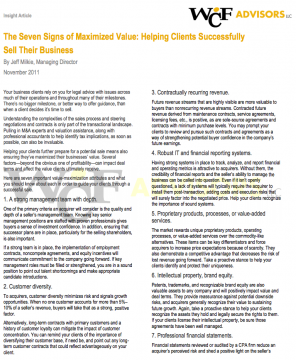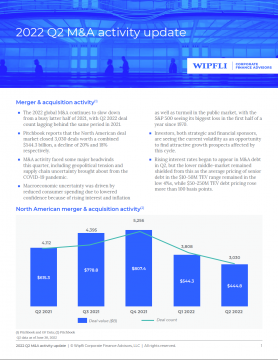The Seven Signs of Maximized Value: Helping Clients Successfully Sell Their Business
Your business clients rely on you for legal advice with issues across much of their operations and throughout many of their milestones. There’s no bigger milestone, or better way to offer guidance, than when a client decides it’s time to sell.
Understanding the complexities of the sales process and steering negotiations and contracts is only part of the transactional landscape. Pulling in M&A experts and valuation assistance, along with professional accountants to help identify tax implications, as soon as possible, can also be invaluable.
Helping your clients further prepare for a potential sale means also ensuring they’ve maximized their businesses’ value. Several factors—beyond the obvious one of profitability—can impact deal terms and affect the value clients ultimately receive.
Here are seven important value-maximization attributes and what you should know about each in order to guide your clients through a successful sale.
1. A strong management team with depth.
One of the primary criteria an acquirer will consider is the quality and depth of a seller’s management team. Knowing key senior management positions are staffed with proven professionals gives buyers a sense of investment confidence. In addition, ensuring that successor plans are in place, particularly for the selling shareholders, is also important.
If a strong team is in place, the implementation of employment contracts, noncompete agreements, and equity incentives will communicate commitment to the company going forward. If key management roles must be filled or strengthened, you are in a sound position to point out talent shortcomings and make appropriate candidate introductions.
2. Customer diversity.
To acquirers, customer diversity minimizes risk and signals growth opportunities. When no one customer accounts for more than 5%– 10% of a seller’s revenue, buyers will take that as a strong, positive factor.
Alternatively, long-term contracts with primary customers and a history of customer loyalty can mitigate the impact of customer concentration. You can remind your clients of the importance of diversifying their customer base, if need be, and point out any long- term customer contracts that could reflect advantageously on your client.
3. Contractually recurring revenue.
Future revenue streams that are highly visible are more valuable to buyers than nonrecurring revenue streams. Contracted future revenue derived from maintenance contracts, service agreements, licensing fees, etc., is positive, as are sole-source agreements and contracts with minimum purchase levels. You may prompt your clients to review and pursue such contracts and agreements as a way of strengthening potential buyer confidence in the company’s future earnings.
4. Robust IT and financial reporting systems.
Having strong systems in place to track, analyze, and report financial and operating metrics is attractive to acquirers. Without them, the credibility of financial reports and the seller’s ability to manage the business can be called into question. Even if it isn’t openly questioned, a lack of systems will typically require the acquirer to install them post-transaction, adding costs and execution risks that will surely factor into the negotiated price. Help your clients recognize the importance of sound systems.
5. Proprietary products, processes, or value-added services.
The market rewards unique proprietary products, operating processes, or value-added services over the commodity-like alternatives. These items can be key differentiators and force acquirers to increase price expectations because of scarcity. They also demonstrate a competitive advantage that decreases the risk of lost revenue going forward. Take a proactive stance to help your clients identify and protect their uniqueness.
6. Intellectual property, brand equity.
Patents, trademarks, and recognizable brand equity are also valuable assets to any company and will positively impact value and deal terms. They provide reassurance against potential downside risks, and acquirers generally recognize their value to sustaining future growth. Again, take a proactive stance to help your clients recognize the assets they hold and legally secure the rights to them. If your clients license their intellectual property, be sure those agreements have been well managed.
7. Professional financial statements.
Financial statements reviewed or audited by a CPA firm reduce an acquirer’s perceived risk and shed a positive light on the seller’s company. Compiled financial statements also provide a level of confidence in the financial information, albeit not as much as reviewed or audited financial statements do. Steer your clients to a quality CPA firm and encourage a review or audit.
Helping your clients minimize perceived risks—operating, financial, market, legal—will always have a positive impact on maximizing business value. Moreover, knowing the seven signs and navigating your clients through each will increase the attractiveness of the companies they’re striving to sell.
Looking to be more acquisitive?
Having an acquisition plan is critical. Start yours now.
Get the checklist now
Categories
Read all Market Updates and Insights
A quarterly, insightful look at middle-market merger and acquisition activity.
Thought-provoking articles on value, growth, and strategy, merger and acquisition news, research and analysis from WCF consultants.





